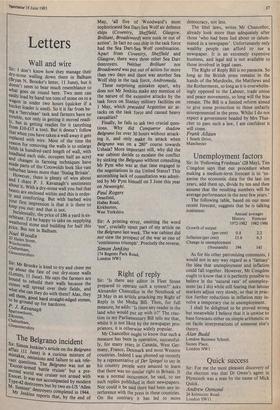Letters
Wall and wire
Sir: I don't know how they manage their dry-stone walling down there in Balham, i (Bryan N. Brooke's letter, 11 June), but it doesn't seem to bear much resemblance to what goes on round here. Two men can easily load by hand ten tons of stone on to a wagon in under two hours (quicker if a bucket loader is used). So it is far from be- ing a 'herculean' task and farmers have no trouble, not only in getting it moved readi- ly, but in getting readies for it (anything from £10-£15 a ton). But it doesn't follow that when you have taken a wall away it gets replaced with wire. Most of the time the reason for removing the walls is to enlarge fields (a hundred-yard length of wall, with headland each side, occupies half an acre) and changes in farming techniques have made parts of the Cotswolds look like vast suburban lawns more than `Stalag However, there is plenty of wire about and I share P. J. Kavanagh's sentiments about it. With a dry-stone wall you feel that beasts are enclosed within and this is order- ly and comforting. But with barbed wire Your first impression is that it is there to keep you out: and that is not.
Incidentally, the price of £86 a yard is ex- orbitant, I'd be happy to take on supplying weathered stone and building for half this price. But not in Balham. Noel Woodin 20 Hailes Street, Winchcombe, Cheltenham, Gloucestershire






































 Previous page
Previous page